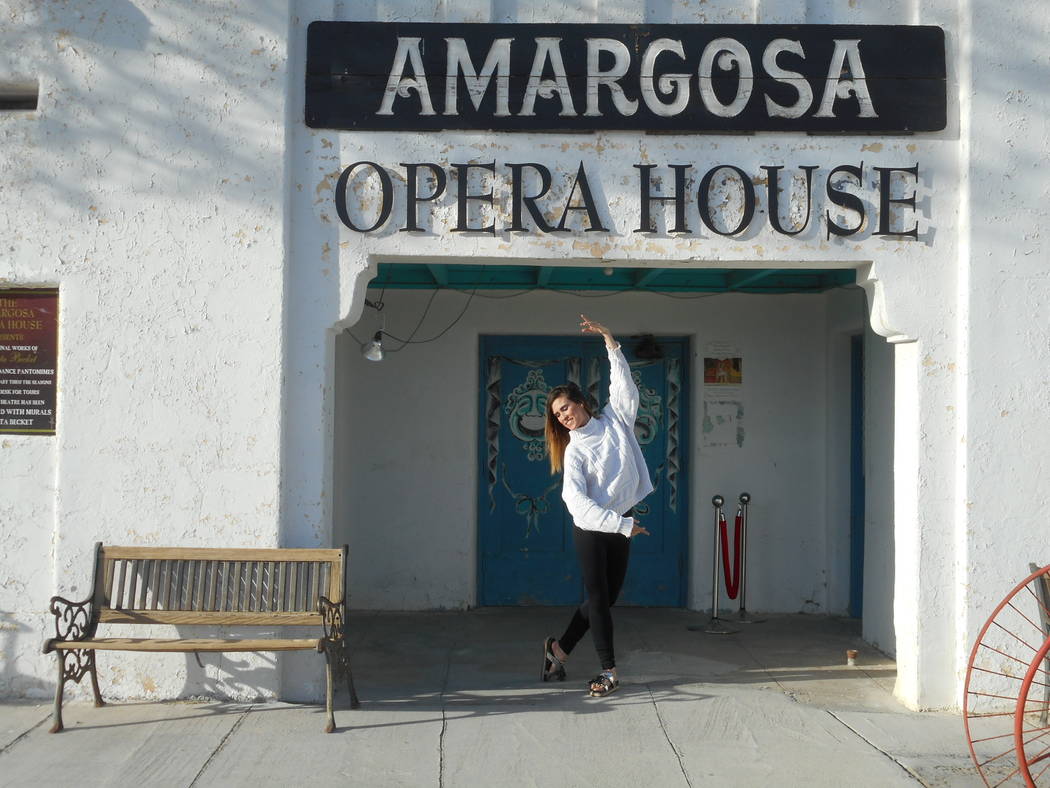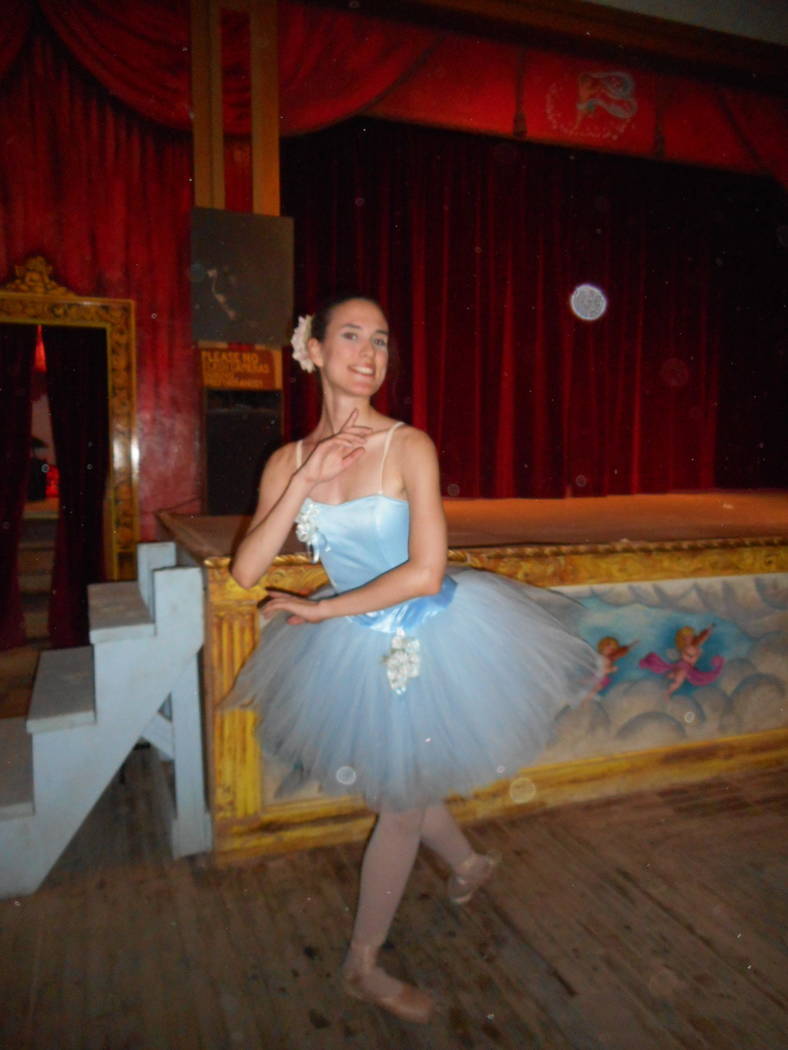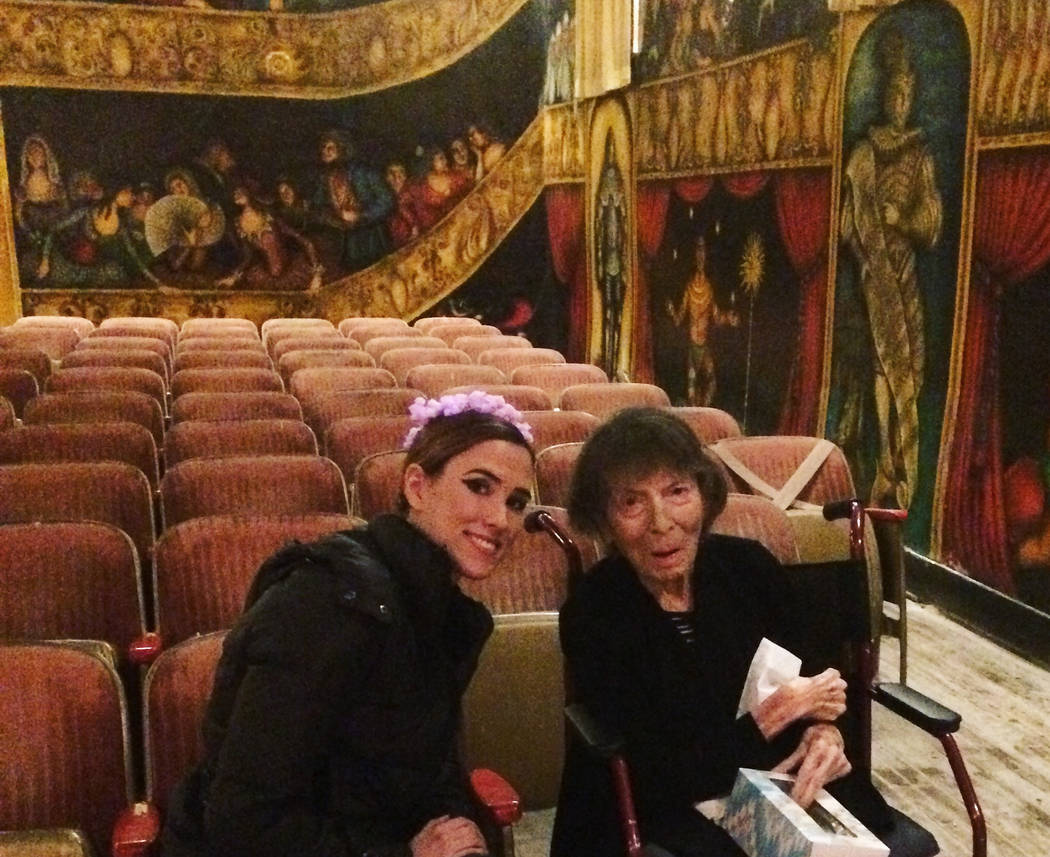Hilda Vazquez dances to keep Becket legacy alive at Amargosa Opera House
On a sunny Friday afternoon in Death Valley Junction, dancer Hilda Vazquez sits in the warm light streaming through the windows of the Amargosa Café.
Against the backdrop of the nearly hundred-year-old building and all the historical photos on the walls, Vazquez looks young and modern in a chunky sweater, scrolling through bright images on her phone.
On the tiny digital screen are precious photos of her mentor Marta Becket, famed artist, dancer and the creative life force behind the Amargosa Opera House for nearly 50 years. Vazquez says she refers back to these photos when she needs a little inspiration.
Since Becket’s death last January, Vazquez has become a sort of conduit between the rich history of the Amargosa Opera House and the future of Becket’s dance legacy. Now, dancing in the footsteps of a legend, Vazquez says she hopes to play a part in keeping that history alive.
It was less than two years ago that Vazquez first met Marta Becket. Becket was 90, Vazquez was 25 and their meeting was the culmination of a series of serendipitous events.
Vazquez was born in the Dominican Republic and was brought to New York City as a small child. In Greenwich Village, where Marta Becket danced as a young woman, Vazquez began studying ballet at the age of four with a teacher she speculates that Becket probably knew.
During her childhood, Vazquez moved several times with her family between the Dominican Republic, Puerto Rico and the United States, providing her the opportunity to study ballet in a variety of fine arts schools.
During a ballet workshop at the Alicia Alonzo school in Cuba, “I heard about Marta for the first time from another student,” Vazquez said. “I think she was from Germany. Someone so far away knew of her and told me about her and I Googled her when I got home.”
A few years later, in the course of her travels, Vazquez came to Pahrump and was staying with a friend. In an upstairs apartment, she continued her daily dance practice, prompting the downstairs neighbor to investigate the source of the noise. When he learned she was a dancer, he said, “You should meet Marta Becket.”
Vazquez said she was stunned by the very idea. “I never thought she would be there, I thought she would be more private, she was such a great artist.”
And then Vazquez was inspired. “I went to see if I could do a dance for her, as a gift,” Vazquez remembers.
At that time she had no thought of dancing on the Opera House stage, she said, only of paying homage to a legend. Becket was unable to see her then, but Vazquez left a note with her contact information, saying she’d be glad to come back anytime.
Some weeks later she said she was surprised to receive a call asking her to come and actually audition for Becket. Dancer Jenna McClintock, the first ballerina to perform Becket’s dances, left Death Valley Junction that spring, and Becket was looking for a replacement.
“I auditioned for her and I told her about my life. When I told her that I had studied with the husband of Alicia Alonzo, she couldn’t believe it. She knew Alicia in New York City at Radio City Music Hall.”
Vazquez began studying Becket’s dances, practicing in a cleared floor space in Becket’s bedroom since the older woman was bedridden much of the time. When Becket was sure that Vazquez could perform to her standards, she gave the go-ahead to announce a new dancer at the Opera House. And when it came time to find costumes for her, the outfits Becket handmade for herself through the years fit Vazquez ‘perfectly’.
Before every show, “Marta would give me inspiring words,” Vazquez said. After every performance, when Becket was too frail to attend, Vazquez would greet visitors “and I would try to remember all their names and everything they said so I could go back and tell it all to her.”
But Becket also encouraged her to create dances of her own, Vazquez said, and midway through the current show she performs a dance she choreographed called “Proserpina.” “It’s a story about a flower. Since she’s from the desert she can only live six months so she enjoys her time in the sun. That’s how I feel when I dance, like a flower.”
When they weren’t talking and practicing dance, Vazquez said the two also spent time together watching art films and critiquing them.
Although Becket was 92 and in poor health, Vazquez said her mentor’s death was still a shock. “I had hoped there would be more time,” she said, “I really miss Marta. At first, I could ask her anything, but now I can’t.”
But the day before Becket died, the two women shared a magical afternoon. One of the images on Vazquez’s phone is from that day. In it, Becket is handing her a book, the story of her life, an autobiography called “To Dance on Sands”.
Becket often ‘danced’ along with her, Vazquez said, lifting her legs even when bedridden.
That afternoon Becket had been wheeled into the theater to watch Vazquez practice. They talked about “To Dance On Sands” and then, as Becket was being wheeled over the soft, sandy ground on the way back to her home, “we danced together,” said Vazquez. “She in her wheelchair and me beside her. She was picking up her legs and doing poses. She truly danced on sands. It was so magical.”
The next day Becket was gone and Vazquez was on her own. She said she never thinks of what she does as dancing in the shadow of a legend.
As a classically trained ballerina, she said, she expects to perform dances rich in history and tradition. “I am here to ensure Marta’s future can keep going on here, that more generations can learn about her.”
“Martha Graham changed the boundaries of ballet, she took her shoes off. Marta Becket made it funny. She had her own way and now it’s established,” Vazquez said.
Her own job now, she added, was to help anchor Becket’s style as “part of the historical repertoire of ballet. I see Marta as one of those grand choreographers of history and time. I want to help make her dances timeless, like Giselle, so others can dance them.”
Marta Becket’s presence, Vazquez said, “was impactful, like a sun filling up the room. She’s always with me when I dance.”
Vazquez dances every Friday and Saturday at 7 p.m. at the Amargosa Opera House in Death Valley Junction. For more information, call the Opera House at 760-852-4441, or visit their website: http://www.amargosa-opera-house.com/index.htm
Robin Flinchum is a freelance writer and editor living in Tecopa, California. Her book, “Red Light Women of Death Valley,” was published last year.


















